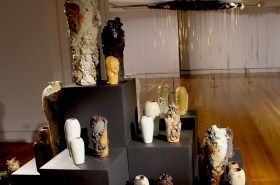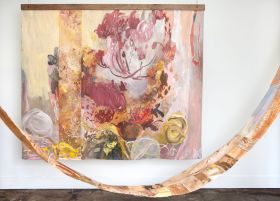Conceptual sculpture by Honi Ryan and Abi Tariq, Photos Not Taken (Here); photo by Keith Maxwell.
There has always been something unique about Sculpture at Scenic World – an exhibition-cum-sculpture festival staged in a Jurassic-aged landscape and whose footfall has zero impact on the forest floor.
One travels down to that incredible environment via a railway with a 52-degree gradient, and the art works are handled by arborists rather than registrars and installers.
What you might deduce from this picture is that the environment is key. Unlike the many sculpture festivals today that grace the banks of lakes, vineyards or coastline boardwalks, Sculpture at Scenic World carries a heavy environmental message at its core – and its voice is getting stronger every year.
But does it deliver aesthetically, and with the conceptual rigour our sector expects? One thing is certain – it is a phenomenal attraction, delivering economic dividends for a tourism-reliant metropolitan town located about two hours out of Sydney in the Blue Mountains.
As Anthea Hammon, co-owner of the family operated Scenic World, said at the exhibition’s opening, ‘Our sustainability, our culture, our community – these are our priorities.’
Sculpture at Scenic World’s position as a regional flagship was recognised by Destination NSW this year via a triennial $27,500 grant. It can only mean that Sculpture at Scenic World will continue to become stronger as an event, as long as it remains curatorially strong.

Installation view of David Jensz’s Ripple, corrugated iron. Photo by Keith Maxwell.
Forget the location, what about the art?
Thirty five artworks by local, national and international artists punctuate the raised 2.4km walkway at Scenic World – it is as far from the white cube as you could possibly imagine.
As with past editions, the breadth of work is spotty in tone and quality, and if anything, feels a little on the slim side this year. It is perhaps exacerbated by congested clusters of works alongside ethereal pieces that seemingly disappear into the landscape. But then this is not an easy environment in which to present art.
Overall, however, this is a strong example of a location-based sculpture festival and there are a number of incredibly well sited, well fabricated and well conceived artworks that inspire a sense of awe and leave an indelible impression.
Among the highlights was David Jensz’s Ripple, which beautifully played with the patina and dappled light of the forest on coiled corrugated iron. It was well resolved in how it sat so lightly on the ground, seeming hovering upon trumpet-like pins, quiet and powerful in its presence.
Jensz was awarded the Blue Mountains Cultural Centre Exhibition Opportunity, which will see this work repositioned from the forest to the white cube.

Installation view of Jan Cleveringa’s Imagining the Past Before it Happens at Sculpture at Scenic World, 2018. Photo by Keith Maxwell.
Other gems include Jan Cleveringa’s installation of 5,000 fluorescent tubes which spoke about sustainability and waste, titled Imagining the Past Before it Happens, and Jane Gillings’ flighty installation of plastic debris, Shaft, which appeared as its title suggests as a shaft of twinkling light carving its way through the forest canopy.
Mitchell Thomas and Bronwen Williams can be commended for their work Quaver, which combines faux painted panels that echo the tree surfaces and rock formations, coupled with sound recordings – again extending the breadth and conceptual underpinning of this exhibition in an exciting direction. As the artists’ explained: ‘The stone skin is vibrating using low-frequency sound, mimicking the subtle movements of the undergrowth.’
It was one of a number of works that introduced sound to the exhibition. Another deserving of mention was Paul Greedy’s Pulse, which was inspired by ‘the immersive modes of listening we experience in natural environments’. Attached high to the trees, the scattered devices had a nostalgic quality reminiscent of steam power, and their tone reverberates with familiarity – is that a bird, rain, echoes?

Installation view of Paul Greedy’s sound piece Pulse, at Sculpture at Scenic World, 2018; photo by Keith Maxwell.
More literal in its message was Jacek Wankowski’s The Drowned World – a small boat that was cast adrift meters above visitors in the forest’s canopy, caught in a conversation about rising sea levels and climate change.
Wankowski was awarded the NAVA Environmental Award for this work.

Installation view of Jacek Wankowski’s The Drowned World, at Sculpture at Scenic World, 2018; photo by Keith Maxwell.
The fine line between overstatement and subtlety is always a hard one to achieve in a sculpture festival of this nature. You need to engage new audiences and curious publics with soft glove familiarity, and yet as the curator of an event seeking international reputation, you need to present strong representation of making now within the sculptural field – both technically and conceptually.
Justin Morrissey handles the job well, and his ability to bridge this space is well managed.
Morrissey told ArtsHub that 80% of the artists included had done site visits this year, and had a considered understanding of the placement of their work. This has almost become a criteria for this exhibition. It prevents the “plonk” phenomenon that is so prevalent with sculpture festivals – where artists just submit a public sculpture from their studio or one left over from another sculpture event – and encourages new work that addresses the very specific environmental context of this site.
Morrissey, and Scenic World, are incredibly committed to this consultative way of working, and it makes for a better exhibition overall.
A good example of that stretch aimed for is the work (pictured top) of Honi Ryan and Abi Tariq titled Photos Not Taken (here), playing off the Instagramable aspect of these events to fuel visibility.
Their conceptual work was simply a didactic panel with a text for consideration – the sculpture to be “imagined” at the hands of the viewer at various points along the walk. It was a really smart and timely play on making now, and I was pleased to see that it was highly commended, encouraging the development of this event in exciting directions.
Similarly taking a fresh take are local Blue Mountain artists and designers Mark and Hannah Surtees with their work Geronimo!, which won the $20,000 major prize.
A simple swing rope hanging in a forest of natural vines, they had illuminated it from within, so on one hand it had the vernacular of a zip and gesture of minimal aesthetics, while on the other it was entirely about play. It proves the point that more is not always better.

Installation view of Mark and Hannah Surtees’ award-winning light sculpture Geronimo!, at Sculpture at Scenic World, 2018; photo by Keith Maxwell.
Signature also to this sculpture exhibition is the breadth of materials utilised – upcycled metals and plastics, glass and ceramics are given strong validation. Of mention are the works of ceramicists Merran Essan and Simon Reece; Freya Jobbins’ usurping of the old Miner’s Hut with a phantasmagorical glut of found plastics; and the work of emerging regional artist Nick Warfield, whose owl made from car fenders – all are sure to be crowd-pleasers with the public.
The real prize, however, is experiencing art in a new way – one that opens art up to new audiences while presenting artists with fresh and renewed challenges.
Rating ★★★☆
Sculpture at Scenic World 2018
Scenic World, Katoomba
13 April – 13 May
For more information, visit www.sculptureatscenicworld.com.au
The writer was a guest of Scenic World.





